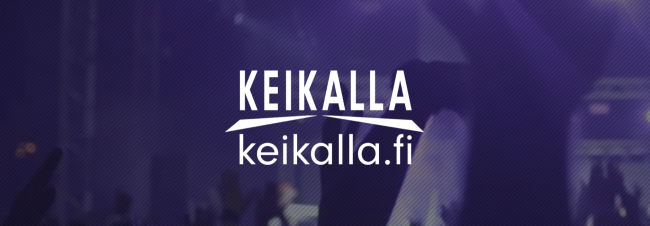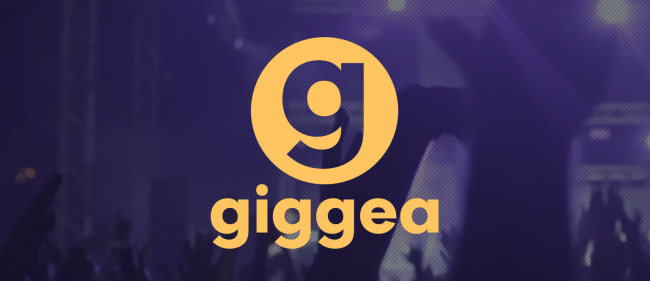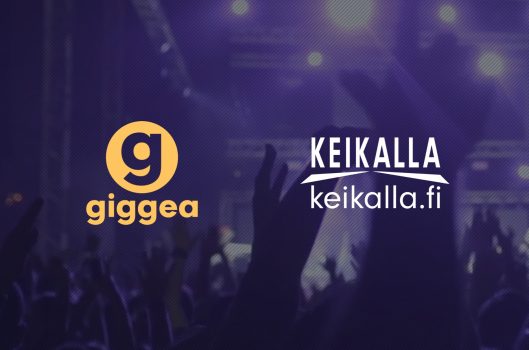Background
Rockway is a Finnish online music learning service operating since 2006 with over 130 000 registered users. During our 14 years of business, we have gained an extensive amount of knowledge, experience and contacts in many related fields on top of education and video production. The company has been run by the same core team for over ten years which has brought solid knowledge and learning in the fast growing business world. We proudly consider ourselves experts in business development, digital marketing, software development, service design, customer management, partnerships and brand building.
The first signs of a COVID-19 lockdown and the effects it might have on the live music business were first seen on 12th of March 2020 when live events started getting cancelled with a swing. We had a feeling that this would hit the live event field like nothing before.
The exact same day we started brainstorming possibilities to help artists whose stream of income was starting to look bad for the summer. We knew we had all the knowledge, tech and contacts available to pull off a livestream service and rolled our sleeves.
As of ensuring the first artists already on the next day March 13th and hearing talks about other livestreaming events were being planned, we knew we had to act fast in order to be first ones on the market with the biggest roster of gigs.
Just three days later, March 16th the new service was online, and a few days later the first shows were on sale. We had done it!
Service development
There are some critical parts of service that needs to be rock solid in order to provide security and quality in live streamed online events. If these key things are not taken into consideration, the service will suffer from severe issues.
The service has to be built to handle big amounts of users doing simultaneous actions in the service, resulting in millions of data requests. If the service architecture is not built correctly, users will experience access and usability problems and in worst cases taking the service down completely.
Stability of the stream provided into the system is another critical factor. If the ingest server gets an unstable signal, the instability will be multiplied to the customer side and effect the stream quality and stability. Even though upstream quality is not a service platform issue, building sufficient monitoring capabilities into the system is. This way problems can be spotted well in advance and be fixed already before the event.

Partnerships
Finding the right partners from the start is crucial for fast growth. With the right partners one can quickly build leverage towards artists, managers, venues, consumers and other essential constituents. When choosing and contacting partners, you should have a clear and good understanding of your field of business. When the vision is clear you should also know where your weaknesses lie and thus are able to find complementing partners.
An online business is first and foremost a lead business, meaning you need a big contacts database you can market to through different channels. This is usually the most valuable asset a digital business has. All additional and relevant user data that can be used to segment contacts and create target groups are also very important.
The bigger your potential customer database is, the quicker the growth. Having millions of contacts in your reach naturally gives you an advantage compared to your competitor, if they are starting from scratch without an existing lead base.
The more data and information you have, the better. In this case if information such as concert purchase history and possible musical interests are available, you can segment your database in order to target contacts and send only relevant messages. This results in more sales and a higher return on investment.
When developing the service, we quickly knew we needed a big and solid customer base and a wide network of artists, labels, promoters and managers. Our own customer database was not too relevant to this new service and market. What we needed was contacts and access to people who already had history buying tickets to live shows. The exact kind of information ticket vendors have.
Through the years we have worked with a variety of ticket vendors and found a big difference in their ways to collect leads and using data. We moved fast and partnered up with the biggest player, Eventim (lippu.fi). They were on board from the get-go.
Before the pandemic broke, we also had talks about co-operations with the Finnish musician’s union. Having them incorporated was quite natural. Co-operating with the union would give us credibility especially in the eyes of promoters, labels and managers.
First mover
Most start-ups fail during their first year of existence and far beyond 90% have gone bankrupt before they’ve reached their 5th year. When starting a new business, timing is critical. If you start your business when the market is not ready for your idea, it usually doesn’t matter how brilliant an idea you have. By being too late, someone else is already ahead of you. Timing is essential.
Being a first mover at the right time gives you a head start. A first mover has a better opportunity to get visibility and media coverage. When something timely and novel comes around, everyone wants to be a part of it and is ready to jump on board, media or partners. This is why a first mover has a much better chance of becoming a household brand in its field and gain wide visibility without almost any cost.
Knowing these things, we wanted to make sure we are the first ones to announce our new streaming service to the world.
We were first and got good media coverage online, radio and TV. The successful launch also resulted in a landslide of contacts from managers, labels, artists, promoters and potential partners. All the live gigs were starting to get cancelled and we had a solution.
Processes and building them
There are obviously no processes, guidelines, standards, or templates when starting up a new venture. These need to be thought of and built in on all areas of the business. Without them the company can not move fast and make decisions nimbly because decision making can’t be delegated and spread out. As soon as norms are built and communicated within the organisation, almost anyone can be the decision maker.
As soon as we had launched the service, we began working on processes and flows like artist onboarding, pre-production, event production, customer service, technical support, business models and process management.
In the early days of a business, everything changes all the time, rapidly. This is also why processes are important, though hard to setup. When you manage to have any kind of processes in place, people know where to look for information and as long as the quickly changing processes are documented, it is much easier to keep everyone up to date with changes and help them working independently.
Business model
The business model is one of the most crucial components of a business. Even with an extraordinarily great idea the business will fail with the wrong model. Finding the right model usually takes many iterations of models. This takes time and a lot of effort. Most of all it requires awareness, reflection, analysing and gut feeling. One has to be aware of what the competition is doing or not doing, and reflect on how the competition is doing compared to oneself. One has to see what the return on investment is in all different areas of the business so that one knows where breakeven is, how and when to reach it and what the margins need to be for healthy growth of the business.
When all these are in order, it all comes down to gut feeling, i.e. being aware of what your instincts tell you you should do. Trusting your gut feeling is the only way you can make decisions especially in times of great uncertainty. This doesn’t mean the decisions should not be data driven, you should always have as much data as possible to support your decisions.
The term ‘business model’ holds in it all aspects of a business that effects its successful operations (customer base, revenue model, financing, production, etc.). You could also think of it as what, where, why and how to sell something and to whom. Or as start-up entrepreneur Simon Sinek narrowed it down in he’s Lean Startup –concept: “why-how-what”. Why does your business exist and why is it relevant? How are you helping customers to solve something important in their life? What is the product?
In our case the ‘why’ started with “to help artists and their constituents get work and income in a situation where all public performance are forbidden and for consumers to have access to entertainment even during a lockdown”.
Looking forward after the pandemic, in order for the business to survive, the ‘why’ needs to be something else and that will most likely change the business model. Our ‘how’ was: by making concerts easily available for consumers and for artists effortless to organise. And finally the ‘what’: we provide an end to end solution for organising, attending, producing, selling and monetising streaming concerts.
From the get-go we decided we would focus on paid for streaming concerts. In this model the first and biggest question was: are consumers ready and willing to pay for online concerts, and if, then how much? Being the first livestream provider to stream gigs, we set the price of tickets at 9,90€, which became the industry standard so far.

Services
Because the company background lies in running an online business, concentrating on video based digital content, we had all the knowledge to create an all-inclusive service for artists, consisting of the online platform and streaming services. This way we could provide an easy access to streamed concerts for any artist. Some artists wanted to use their own production crew and deliver the stream to our platform.
The most important part of delivering a livestream is having a platform that is robust and can scale up according to the amount of viewers and being able to deliver a steady, good quality stream. Knowing our platform was built to handle a large number of simultaneous requests and having 7 years of experience in live streaming video, most of the possible problems were known to us. What was new to us was having to deal with video production subcontractors, their varying equipment, experience and a variety of different internet connections in different venues.
Early on we could see that the quality and stability of the upstream from a venue to the platform is the most crucial part of the whole value chain. By always making sure we got a steady and quality stream through a stable connection and a quality streamer, we’ve managed to deliver over 60 concerts so far, without failure. The amount of concerts delivered is also over double the amount any other service has delivered so far.
Production-wise we wanted to focus on quality, rather than trying to be the cheapest option because we knew the competition in the low budget range was big. We chose to hold a TV-production standard on our in-house productions to deliver full HD quality streams, with picture quality no-one could beat. Especially in the beginning, when managers and labels were evaluating the quality of the service, we did all the production with our own crew, to make sure they would always see a high quality stream in order to convince customers that they were getting more than they paid for. This way we wanted to build a brand image of quality and reliability.
Customer service and flow
Another important part of the experience is ease of use, clarity and level of customer service. All of which help to get as many returning customers as possible. The trickiest part is to create an easy customer flow all the way from marketing funnels, through ticket purchase, to redeeming the ticket and enjoying the show. This flow should be as short as possible, leaving as little room for confusion as possible. Having an external ticket vendor, makes this flow longer and trickier because of having to funnel the customer through two different services with two different logins and thus increasing the possibility of the customer being lost along the way. This part of the whole experience is the part that needs most attention and improvement moving forward. Even more important is making the customer feel we are there to help and doing everything possible for them to have a great experience. This is done only by outstanding customer service, something we made sure to deliver. Before and during each show we have customer service online both through chat, e-mail and phone, in order to make sure everyone gets to enjoy the gig and be helped on the spot should any problems occur.
Different events
During the four months of the service being up and running, we have streamed over 60 performances from all parts of Finland and sold tens of thousands of tickets. So far most events have consisted of music, but we have also delivered other performances, like dance, stand-up and theatre. We’ve also had the pleasure to be the first ones to deliver an online only music festival, April Jazz. This yearly four day festival was initially cancelled this year, but together with us they managed to organise the festival as an all online version.
Together with Kummit Ry we also arranged the first ever completely online fundraiser stream, that starred Elastinen, with guest appearances by Paula Vesala and Jenni Vartiainen. Through the event Kummit managed to raise over 50 000€ for children with mental health problems.
As venues were allowed to organise concerts with a small amount of spectators, we made hybrid events possible, meaning the possibility to attend the concert live onsite, or through a livestream. For these events we also sold onsite tickets, that also included the right to watch the concert afterwards on demand at home. This has given us good experience for the future, when society turns back to normal, and new products and concepts need to be developed for an ever growing online audience.
International first steps
In early may we were contacted by Eventim, the biggest ticket vendor in Europe. Them being the owner of our partner lippu.fi, had heard of our partnership and how well everything had gone. Specifically, Eventim Scandinavia wanted to also use our services to be able to stream events from other Scandinavian countries. After quite quick negotiations, we signed a preferred partner contract with them. Our first international events were streamed in June. So in just two months from starting the service, we had already made the venture international. After signing with Eventim Scandinavia, we have continued talks with the Netherlands, Great Britain and Spain, to further our international co-operation with Eventim.
Future visions
As of the end of June, streamed events came to an abrupt decline in Finland, as the whole country went into vacation mode. How big the need for streamed events will be during the fall of 2020 remains to be seen. We, however believe there will be an ever growing demand in streaming events, and that new concepts and business models will emerge. We intend to be not only a part of this new business, but remain forerunners in the game. First steps being to ensure wide co-operations with big players in the market, to secure a great portion of the market shares.
Niklas Lindholm / CEO



